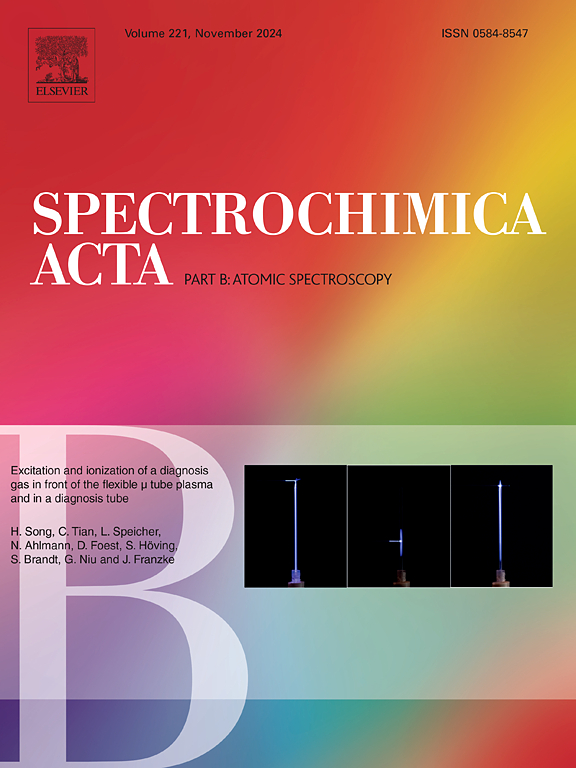以HPLC-HG-AFS为重点的硒氨酸定量鉴定多技术平台
IF 3.2
2区 化学
Q1 SPECTROSCOPY
引用次数: 0
摘要
硒氨酸是生物群中天然存在的硒(Se)的一种形式,近年来在营养、药物开发和环境研究等领域引起了相当大的兴趣。硒氨酸具有很强的抗氧化能力,这使它成为人类或农场动物潜在的硒补充剂。目前还缺乏一种可靠且具有成本效益的在线物种形成方法来确定这种具有生物学相关性的硒物种。本研究建立了一种同时分析硒氨酸和其他有机硒的方法。它基于反相液相色谱、紫外辐射、热处理、氢化物生成和原子荧光光谱(HPLC-UV-TT-HG-AFS)的在线耦合。采用外标法对硒氨酸进行了定量测定,并将其从常见的有机硒种(硒代蛋氨酸、硒甲基硒半胱氨酸)中分离出来。提出的方法导致线性响应(R2 >;0.999),浓度范围为5 ~ 100 μgSe L−1,检测限为0.5 μgSe L−1。重复性为0.8%,重现性为1.6%。该分析方法用途广泛,成本效益高,色谱运行时间短于12分钟。HPLC-ICP-MS的高选择性与HPLC-ESI-MS/MS的物种鉴定能力相结合,对于获得进一步的物种形成见解和确认HPLC-UV-TT-HG-AFS获得的结果是非常宝贵的。该方法可作为生物样品中硒氨酸常规分析的有用工具,如图所示为海鸟肝脏提取物的分析。本文章由计算机程序翻译,如有差异,请以英文原文为准。

A multi-technique platform for the quantification and identification of selenoneine with a focus on HPLC-HG-AFS
Selenoneine, a naturally occurring form of selenium (Se) in biota, has recently raised considerable interest in the fields of nutrition, drug development and environmental research. Selenoneine has a strong antioxidant capacity which makes it a potential Se supplement for humans or farm animals. There is a lack of a reliable and cost-effective online speciation methodology for the determination of such a biologically relevant Se species. In this study, a method has been developed for the simultaneous analysis of selenoneine and other organic Se species. It is based on the online coupling of reversed-phase liquid chromatography, ultraviolet radiation, thermal treatment, hydride generation and atomic fluorescence spectrometry (HPLC-UV-TT-HG-AFS). Quantitative determination of selenoneine by external calibration and its separation from commonly found organic Se species (selenomethionine, Se-methyl-selenocysteine) was achieved. The proposed methodology resulted in a linear response (R2 > 0.999) for a concentration range of 5–100 μgSe L−1 and a limit of detection of 0.5 μgSe L−1. The repeatability was 0.8 %, with a reproducibility of 1.6 %. This analytical approach is versatile, cost-effective, and fast with a chromatographic runtime of less than 12 min. The high selectivity of HPLC-ICP-MS, combined with the species identification power of HPLC-ESI-MS/MS was found invaluable for gaining further speciation insights and confirming the results obtained by HPLC-UV-TT-HG-AFS. The developed approach could serve as useful tool for routine selenoneine analysis in biological samples as shown here with the analysis of seabird liver extracts.
求助全文
通过发布文献求助,成功后即可免费获取论文全文。
去求助
来源期刊
CiteScore
6.10
自引率
12.10%
发文量
173
审稿时长
81 days
期刊介绍:
Spectrochimica Acta Part B: Atomic Spectroscopy, is intended for the rapid publication of both original work and reviews in the following fields:
Atomic Emission (AES), Atomic Absorption (AAS) and Atomic Fluorescence (AFS) spectroscopy;
Mass Spectrometry (MS) for inorganic analysis covering Spark Source (SS-MS), Inductively Coupled Plasma (ICP-MS), Glow Discharge (GD-MS), and Secondary Ion Mass Spectrometry (SIMS).
Laser induced atomic spectroscopy for inorganic analysis, including non-linear optical laser spectroscopy, covering Laser Enhanced Ionization (LEI), Laser Induced Fluorescence (LIF), Resonance Ionization Spectroscopy (RIS) and Resonance Ionization Mass Spectrometry (RIMS); Laser Induced Breakdown Spectroscopy (LIBS); Cavity Ringdown Spectroscopy (CRDS), Laser Ablation Inductively Coupled Plasma Atomic Emission Spectroscopy (LA-ICP-AES) and Laser Ablation Inductively Coupled Plasma Mass Spectrometry (LA-ICP-MS).
X-ray spectrometry, X-ray Optics and Microanalysis, including X-ray fluorescence spectrometry (XRF) and related techniques, in particular Total-reflection X-ray Fluorescence Spectrometry (TXRF), and Synchrotron Radiation-excited Total reflection XRF (SR-TXRF).
Manuscripts dealing with (i) fundamentals, (ii) methodology development, (iii)instrumentation, and (iv) applications, can be submitted for publication.

 求助内容:
求助内容: 应助结果提醒方式:
应助结果提醒方式:


